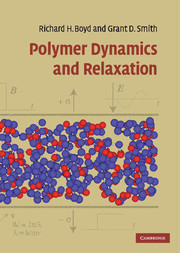
-
Select format
-
- Publisher:
- Cambridge University Press
- Publication date:
- 10 November 2009
- 13 September 2007
- ISBN:
- 9780511600319
- 9780521814195
- 9780521152914
- Dimensions:
- (247 x 174 mm)
- Weight & Pages:
- 0.688kg, 266 Pages
- Dimensions:
- (244 x 170 mm)
- Weight & Pages:
- 0.43kg, 266 Pages
- Subjects:
- Engineering, Materials Science
You may already have access via personal or institutional login- Subjects:
- Engineering, Materials Science
Book description
Polymers exhibit a range of physical characteristics, from rubber-like elasticity to the glassy state. These particular properties are controlled at the molecular level by the mobility of the structural constituents. Remarkable changes in mobility can be witnessed with temperature, over narrow, well defined regions, termed relaxation processes. This is an important, unique phenomenon controlling polymer transition behaviour and is described here at an introductory level. The important types of relaxation processes from amorphous to crystalline polymers and polymeric miscible blends are covered, in conjunction with the broad spectrum of experimental methods used to study them. In-depth discussion of molecular level interpretation, including atomistic level computer simulations and applications to molecular mechanism elucidation, are discussed. The result is a self-contained approach to polymeric interpretation suitable for researchers in materials science, physics and chemistry interested in the relaxation processes of polymeric systems.
Reviews
Review of the hardback:'The authors have a real gift for conveying the gist of an idea intelligently and effectively … the book is consistently accessible and clear-headed in a way that can engage many an undergraduate's interest … warmly recommended. Boyd and Smith have done a good job of explaining the problems and will certainly get you thinking.'
Source: Current Engineering Practice
Contents
Metrics
Full text views
Full text views help Loading metrics...
Loading metrics...
* Views captured on Cambridge Core between #date#. This data will be updated every 24 hours.
Usage data cannot currently be displayed.
Accessibility standard: Unknown
Why this information is here
This section outlines the accessibility features of this content - including support for screen readers, full keyboard navigation and high-contrast display options. This may not be relevant for you.
Accessibility Information
Accessibility compliance for the PDF of this book is currently unknown and may be updated in the future.


